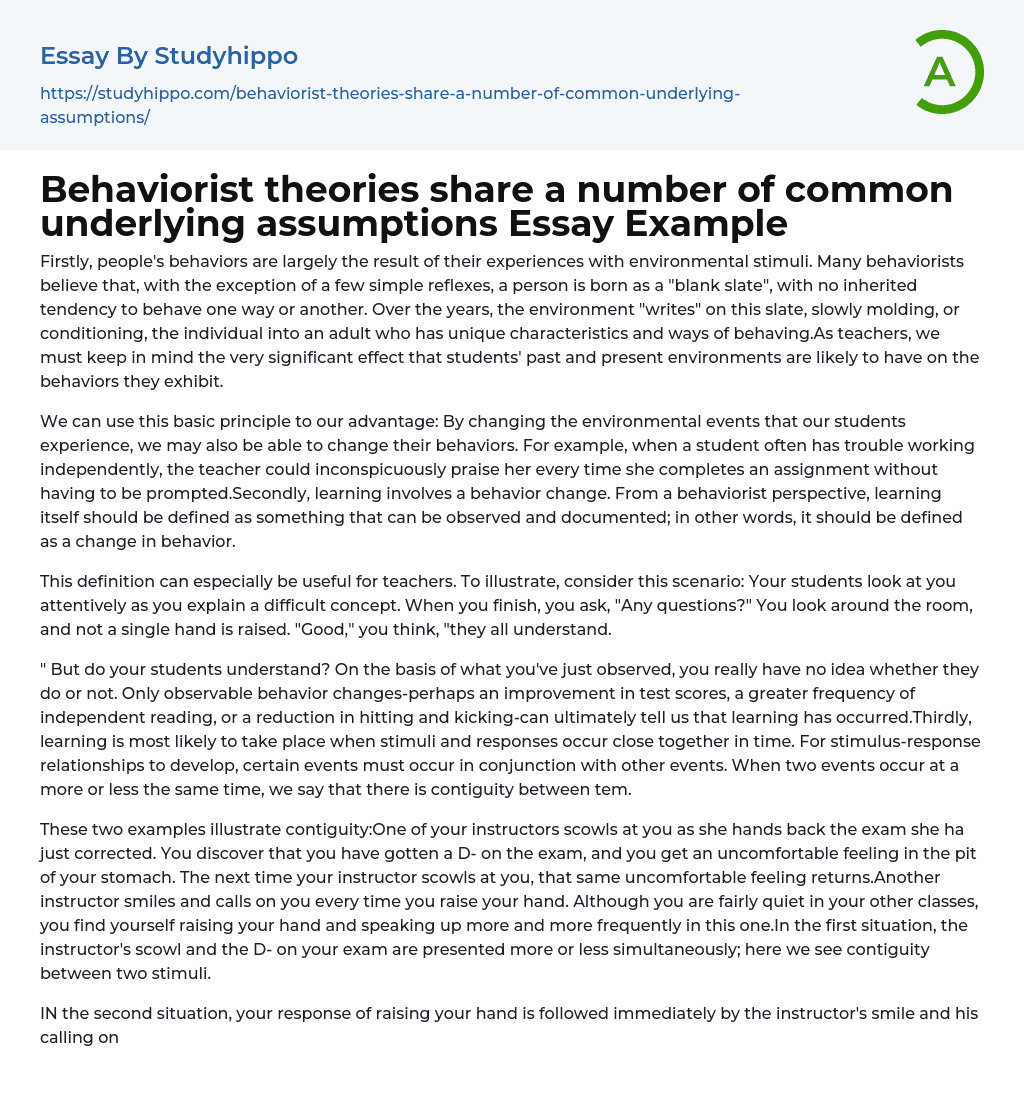

Behaviorist theories share a number of common underlying assumptions Essay Example
Firstly, people's behaviors are largely the result of their experiences with environmental stimuli. Many behaviorists believe that, with the exception of a few simple reflexes, a person is born as a "blank slate", with no inherited tendency to behave one way or another. Over the years, the environment "writes" on this slate, slowly molding, or conditioning, the individual into an adult who has unique characteristics and ways of behaving.As teachers, we must keep in mind the very significant effect that students' past and present environments are likely to have on the behaviors they exhibit.
We can use this basic principle to our advantage: By changing the environmental events that our students experience, we may also be able to change their behaviors. For example, when a student often has trouble working independently, the teacher could inconspicuously praise her
...every time she completes an assignment without having to be prompted.Secondly, learning involves a behavior change. From a behaviorist perspective, learning itself should be defined as something that can be observed and documented; in other words, it should be defined as a change in behavior.
This definition can especially be useful for teachers. To illustrate, consider this scenario: Your students look at you attentively as you explain a difficult concept. When you finish, you ask, "Any questions?" You look around the room, and not a single hand is raised. "Good," you think, "they all understand.
" But do your students understand? On the basis of what you've just observed, you really have no idea whether they do or not. Only observable behavior changes-perhaps an improvement in test scores, a greater frequency of independent reading, or a reduction in hittin
and kicking-can ultimately tell us that learning has occurred.Thirdly, learning is most likely to take place when stimuli and responses occur close together in time. For stimulus-response relationships to develop, certain events must occur in conjunction with other events. When two events occur at a more or less the same time, we say that there is contiguity between tem.
These two examples illustrate contiguity:One of your instructors scowls at you as she hands back the exam she ha just corrected. You discover that you have gotten a D- on the exam, and you get an uncomfortable feeling in the pit of your stomach. The next time your instructor scowls at you, that same uncomfortable feeling returns.Another instructor smiles and calls on you every time you raise your hand. Although you are fairly quiet in your other classes, you find yourself raising your hand and speaking up more and more frequently in this one.In the first situation, the instructor's scowl and the D- on your exam are presented more or less simultaneously; here we see contiguity between two stimuli.
IN the second situation, your response of raising your hand is followed immediately by the instructor's smile and his calling on you; in this case, we see contiguity between a response and two stimuli (although smiling and calling on you are responses that the instructor makes, the are stimuli for you). IN both situations, your behavior has changed: You've learned to respond with an unpleasant feeling in your stomach every time a particular instructor scowls, and you've learned to raise your hand and speak up more frequently in another instructor's class.
- Perseverance essays
- Expressive essays
- Character Traits essays
- Apology essays
- Compassion essays
- Academia essays
- Higher Education essays
- Language Learning essays
- Studying Business essays
- Education System essays
- Study essays
- First Day of School essays
- Scholarship essays
- Pedagogy essays
- Curriculum essays
- Coursework essays
- Studying Abroad essays
- Philosophy of Education essays
- Purpose of Education essays
- Brainstorming essays
- Educational Goals essays
- Importance Of College Education essays
- Brown V Board of Education essays
- The Importance Of Higher Education essays
- Online Education Vs Traditional Education essays
- Academic And Career Goals essays
- Academic Integrity essays
- Brown Vs Board Of Education essays
- Distance learning essays
- Technology in Education essays
- Vocabulary essays
- Writing Experience essays
- Importance of Education essays
- Early Childhood Education essays
- Academic Degree essays
- Academic Dishonesty essays
- School Uniform essays
- Academic writing essays
- Cheating essays
- Bachelor's Degree essays
- MBA essays
- College Life essays
- Grade essays
- Diploma essays
- Phonology essays
- Sentence essays
- Filipino Language essays
- Pragmatics essays
- Millennium Development Goals essays
- History Of Education essays



